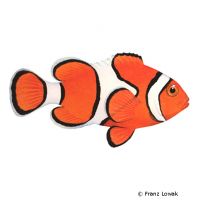Orange Clownfish (Amphiprion percula)
| Orange Clownfish Amphiprion percula | |
|---|---|
| Name | Orange Clownfish |
| Name Lat. | Amphiprion percula |
| Family | Damselfishes |
| Family lat. | Pomacentridae |
| Order | Ovalentarias |
| Order lat. | Ovalentaria inc. sed. |
| Origin | Western Pacific |
| Habitat | Lagoons, seaward reefs |
| Diet | Omnivore |
| pH | 8.1-8.4 |
| Hardness | 8-10 °KH |
| Behavior | Semi-aggressive |
| Keeping | Pair with host anemone |
| Reef Compatible | Yes |
| Care Level | Easy |
| Life Span | 5-10 years |
| Protection | No |
| Metric Units | |
| Size | 9 cm |
| Temperature | 24-27 °C |
| Salinity | 33-36 ‰ |
| Aquarium | ~ 300 l |
| US Units | |
| Size | 3" |
| Temperature | 75-81 °F |
| Salinity | 1.020-1.025 sg |
| Aquarium | ~ 80 gal |
Distribution and habitat
The range of Amphiprion percula is the Western Pacific, from the Great Barrier Reef and New Guinea to Melanesia, where they live in lagoons and coral reefs in symbiosis with anemones.
Maintenance
The aquarium should have a reef structure with living stones that act as a biological filter and at least one host anemone that serves as a hiding place, resting place and retreat, as well as sufficient swimming space. Only calcareous, heavy metal-free sands, gravels, stones or sea sand of various grain sizes may be used as substrate.
Filters, skimmers and heaters are necessary to ensure water quality, as well as pumps to simulate tides, swells and bottom currents. Lighting must correspond to the species-appropriate day-night rhythm of the animals
| Salinity: 33-36 ‰ | pH value: 8.1-8.4 |
| Carbonate hardness: 8-10 °KH | Nitrate content: 2-8 mg/l |
| phosphate content: 0.01-0.1 mg/l | nitrite content: 0.0-0.05 mg/l |
For salinity, an average value should be aimed for, which may only vary slightly by +/- 0.5 ‰. Ammonia and ammonium must not be measurable. Special attention must be paid to constantly good water quality.
Diet
They feed mainly on animal food, but also require plant food. The food supply should consist of a combination of small mysis, krill and artemia as well as chopped fish, mussel and squid meat, supplemented with a commercially available, frozen special food mix. In addition, high-quality granulated or flake food with a high vegetable content (e.g. spirulina, kelp). It is recommended to feed small portions several times a day (3-5 times)
Regular and varied feeding promotes health and increases resistance.
Behaviour and compatibility
They must be kept in pairs with a host anemone, such as Heteractis magnifica, Heteractis crispa or Stichodactyla gigantea, with which they live in symbiosis. The dominant, larger animal always develops into the female. They are monogamous and defend their host anemone together. There may be intraspecific incompatibility as well as incompatibility with other anemonefish. They can be well socialized with other peaceful fish.
Sex dimorphism
They are protandrous hermaphrodites, i.e. the females develop from functional males when needed. The female is significantly larger than the male.
Reproduction and breeding
The breeding has already succeeded over several generations. The spawn is deposited at the foot of the anemone and the male performs the brood care. The larvae hatch after 6-11 days and must be fed several times a day with special rearing food (zooplankton).
Important
They find protection in the cnidarian tentacles of their host anemone and defend it against predators. They gain protection from the stinging venom by taking over ('cuddling') body mucus from their symbiotic anemone
If different species are kept together, care must be taken to ensure that the fish match each other in terms of water quality and temperature requirements, as well as their social behavior, and that the setup meets the needs of all species kept together. New fish to be introduced must be acclimated slowly to the water in the aquarium.
Further literature can be found in your pet store.
References
Text: Werner Winter; Image: Franz Lowak
Source: KUITER, DEBELIUS (2007): Atlas der Meeresfische: Die Fische an den Küsten der Weltmeere, Kosmos Verlag; BAENSCH & PATZNER (1998): Meerwasser Atlas Bd. 7, Mergus Verlag; ENGELMANN (2005): Zootierhaltung - Tiere in menschlicher Obhut: Fische, Verlag Harri Deutsch
- Gemäß § 21 Abs. 5 Tierschutzgesetz idgF
